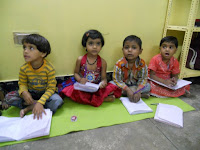 Congratulations, your kid’s name is in the shortlist. You will have to pay Rs 1 lakh in cash. This is what many parents seeking nursery admissions for their children were told in school after school. The words and sum sought may have varied but the essence remained. You want a seat for your kid, you pay! You do not get any receipt and of course no refund. Hard to believe. But we have it from the horse’s mouth!
Congratulations, your kid’s name is in the shortlist. You will have to pay Rs 1 lakh in cash. This is what many parents seeking nursery admissions for their children were told in school after school. The words and sum sought may have varied but the essence remained. You want a seat for your kid, you pay! You do not get any receipt and of course no refund. Hard to believe. But we have it from the horse’s mouth! A recent sting operation by a leading News Channel exposed the shocking reality. What is even more distressing is the reason proffered by some: “We have no management quota. We only have EWS quota, where we have to teach kids for free. Earlier, 100 per cent of seats were liable to pay fee. Now it is not so. It is such a big school. How else do we recover our money spent?” Can you believe it. We had been led to believe that the 20% reservation in schools for poor children was an option to the common school which is something I dream of and was a way forward towards implementing the Right to Education Act. However we forgot that we are in India and ways would be found to circumvent the law. Now if schools thought of passing on the cost to the helpless parent, parents found their way too: resorting to getting fake EWS certificates. What gave them away their ability was their faultless English! I was always held that English made all the difference. Oops there is one option I forgot to mention: the tout! Give 250 000 Rs and your child gets his seat.
All this makes a mockery of the RTE bill and the whole EWS process. For me, the whole EWS was flawed and doomed to fail. When quizzed about the matter our CEO gave her jaded answer: I have not got any complaint, if I get one we will take action! But who will bell the cat, Madam. We are talking of harrowed parents worried about their child’s future. Sad but true: education is now a business with its own market forces.
Many uncomfortable questions come to mind and need to be addressed. To do see we need to take a little time and view the education scenario prevalent today. There are many kinds of schools. At one end of the spectrum the ones for the uber rich that are the prerogative of those who can afford them. Fees are astronomical. On the other end of the spectrum are the municipal schools that are in a pathetic conditions and hence not an option. In between you have the whole range of what goes by the name of public schools and the few better run government schools. There are public schools of all shade and hues that cater to the different strata of society. Some have a well established reputation and often in Delhi you have children traveling hours in buses to reach the school chosen by their parents. I remember how my own daughter had to travel to almost the other end of town as her school had shifted from a close location to another one. Blissfully we got transfered and the inane rides ended.
Admissions to schools has always been a nightmare. Many of us remember the interview process, the testing of toddlers and the rejection trauma. Every school has its own admission procedure and what ensued was mayhem. It was then decided to streamline the procedure and moot a common admission system. After much debate and discussion by all stakeholders a policy was drafted and a 100 point system established. So you were at an advantage if your child was a girl, lived in the school neighborhood, had a sibling in school. If you were an alumni then all the better and your qualifications mattered to! It all seemed flawed and unfair. So if you are a boy, a first child, and your parents are not well educated you run the race with a huge handicap. As for the neighborhood criteria I know first hand parents who were busy last month making fake tenancy agreement from diverse locations. So much for a transparent system. And as for the recommendation of having an affordable and common admission form.. forget it! Schools have individual forms that can cost anything from 200 to 1000 rs. So if you apply in different schools then be prepared to dish out a hefty sum. Admissions are a big business with good returns for the schools.
So what are the solutions. If we are to honour the RTE then it is time to address realities. A growing middle class means that capacity has to be increased and state run schools improved. Government schools sit on prime property and are well distributed across the city. It is time they were made a good if not the only option for the middle class. Over 700 such schools dispense early education but the quality is abysmal and thus not an option. As long as the state shuns its responsibility the yearly nightmare for young parents will continue and public schools will continue their aberrations. The children of India deserve their Right to Quality Education.




